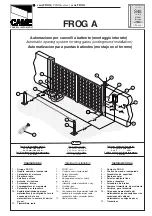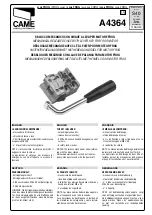
10
ADDITIONAL LIGHTNING PROTECTION
For those areas where a high probability of ground lightning strikes
exists (Florida, Georgia, etc.), additional lightning protection should be
installed in the LP1000. Although it may not be possible to protect
against all strikes, additional protection will substantially reduce the
occurrence of lightning damage. Allstar’s lightning data indicates that
the most strikes enter the LP1000 through the power lines. Effective
protection requires that the surge current from the lightning strike be
shunted to ground. This must be done without raising the potential of
the circuitry in the LP1000, with respect to ground, to the levels that
will damage the solid state circuitry. Lightning strikes generate
enormous currents for very short periods of time. Unfortunately, the
period of time is long enough to damage solid state components and
many times, other components. The key to success is a very low
resistance path from the surge protector to ground for these currents in
addition to a surge protector that will act fast enough to protect the solid
state circuitry. Several manufacturers offer suitable surge protectors.
ACCESSORY EQUIPMENT HOOK-UP
All accessory equipment is hooked-up to the 17-terminal barrier strip
located on the back of the control box. See Figure 11. There are no
installer connections inside the control box. NO ACCESSORY
EQUIPMENT SHOULD BE INSTALLED IN THE CONTROL BOX!
If local electrical codes permit, use the operator's bottom plate for
mounting accessory components. Otherwise, install the accessory
equipment in an appropriate electrical box.
The thirteen (13) command inputs for the LP1000 require a switch
closure to COMMON of less than 100 OHMS resistance and for more
than 100 milliseconds duration. Two of the inputs - ALTERNATE and
RADIO OPEN - are momentary inputs where the signal must be
released and re-entered to be recognized. The remaining inputs can be
continuous signals. A label on the left side of the control box lists the
function of each of the terminals on the barrier strip, see Figure 11.
Also see the Reference Chart on Page 17 and 18.
WIRING REVERSING VEHICLE DETECTORS
Place the detector on the bottom plate of the LP1000 frame or in a
remote electrical box, NEVER in the control box. Hook-up the power
and loop wires on the detector harness according to the manufacturer's
instructions. Crimp 1/4" quick disconnect lugs to the RELAY
COMMON and PRESENCE OUTPUT wires on the detector harness.
The RELAY COMMON wire is connected to terminals #16,
COMMON, on the control box 17 position terminal strip. The
PRESENCE OUTPUT wire is connected to terminal #11, REV LOOP.
See Figure 10, for a typical installation. Also see Figure 24, page 20.
Set the detector frequency and sensitivity switches on the detector
according to the manufacturer's instructions.
WIRING FREE EXIT DETECTORS
The installation of a free exit loop detector is identical to a vehicle loop
detector with the following exceptions:
Connect the PRESENCE OUTPUT wire of the detector wiring harness
to terminal #5, FREE EXIT, on the 17 position terminal strip. The
RELAY COMMON wire is connected to terminals #16, COMMON.
See Figure 24, page 20.
Figure 11: 17 Position Terminal Strip
110144
W A R N I N G !
TO REDUCE THE RISK OF DAMAGE DUE TO
LIGHTNING, ENSURE A SOLID GROUND FROM THE
LEADER PLUS GROUND WIRE IN THE SERVICE
ENTRANCE 4 x 4 HANDY BOX TO THE ELECTRICAL
SERVICE GROUND OR TO A EARTH GROUND STAKE
NEAR THE LEADER
IMPROPER WIRING COULD CAUSE
ELECTROCUTION OR DAMAGE TO CIRCUITRY.
FOLLOW LOCAL BUILDING AND ELECTRICAL
CODES.
W A R N I N G !
C
: INSTALLING THE OPERATOR










































